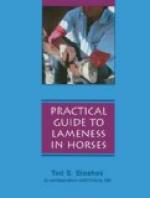Acute arthritis begins like an ordinary attack of synovitis. In joints other than the pedal and pastern, there is sudden and extensive swelling, which at first is intra-articular, succeeded by extra-articular tumefaction, and accompanied by violent lameness. The pain soon becomes intense and agonizing. There is severe constitutional disturbance, the temperature ranging from 104 to 106 degrees and the pulse from 60 to 72. Painful convulsions of the limb occur, shown by involuntary spasmodic elevations due to reflex irritation of the muscles. There is loss of appetite, rapid emaciation, the flank is tucked up and the back arched. In from three to six days, the tumefaction around the joint tends to soften at a particular place, and bursts, and a discharge that is sometimes of a sanious character, mixed with synovia, escapes. Great exhaustion at times supervenes, and if the joint is an important one, the horse lies or falls and is unable to rise.
Treatment.—In small puncture wounds the immediate application of a vesicating ointment has given good results, but when infection has taken place to such extent that the animal manifests evidence of intense pain, and lameness is marked and local swelling and hyperesthesia are great, vesication is contraindicated. In such instances the exterior of the wound and its margins should be prepared as in similar affections of other joints. A quantity of synovia is then aspirated by means of a small trocar and care should be taken to observe all due aseptic precautions. Subsequently the injection of from four to six ounces of a mixture of tincture of iodin, one part to ten parts of glycerin, and gentle massage of the joint immediately after the injection has been made, serves to check the infective process in some cases.
The subject should be cared for as has been previously suggested in arthritis proper provisions for comfort being made. Good nursing is always essential to a successful issue. However, the author cannot view cases of open stifle joint with the same optimism concerning their course and outcome that is expressed by a number of writers on this subject. It is a grave condition wherein the prognosis should be given advisedly.
Fracture of the Tibia.
Etiology and Occurrence.—Because of its exposed position to kicks, and its lack of protection by heavy musculature (especially on its inner surface), there is afforded ample opportunity for frequent injury to the tibia. Fractures are complete and varying as to nature, or incomplete. The heavy tibial fascia affords sufficient protection so that fissures without entire solution of continuity of the bone may occur from violence to which this part is often subjected. Moeller classes tibial fracture as ranking second in frequency—pelvic fracture being more often met with in horses. This does not apply in our country as phalangeal and metacarpal and even metatarsal fractures are observed in more instances than are such injuries to the tibia. The tibia is occasionally broken at its middle and lower thirds, but malleolar fractures are not common.




